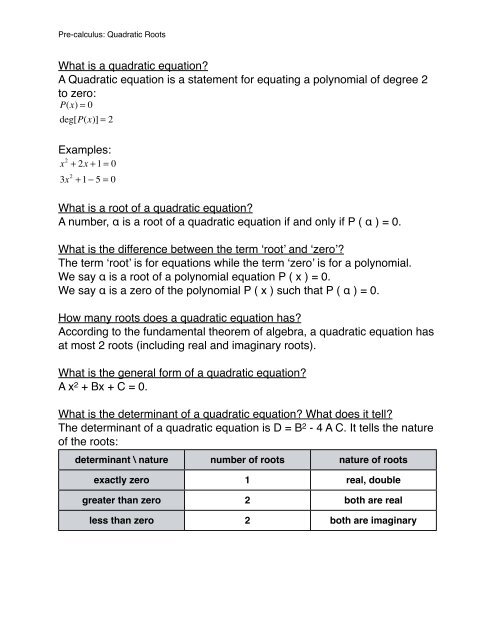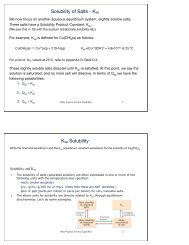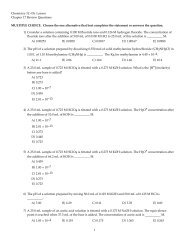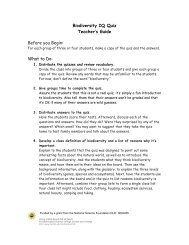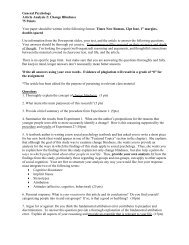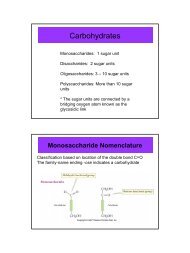What is a quadratic equation? A Quadratic equation is a statement ...
What is a quadratic equation? A Quadratic equation is a statement ...
What is a quadratic equation? A Quadratic equation is a statement ...
You also want an ePaper? Increase the reach of your titles
YUMPU automatically turns print PDFs into web optimized ePapers that Google loves.
Pre-calculus: <strong>Quadratic</strong> Roots<br />
<strong>What</strong> <strong>is</strong> a <strong>quadratic</strong> <strong>equation</strong>?<br />
A <strong>Quadratic</strong> <strong>equation</strong> <strong>is</strong> a <strong>statement</strong> for equating a polynomial of degree 2<br />
to zero:<br />
P(x) = 0<br />
deg[P(x)] = 2<br />
Examples:<br />
x 2 + 2x + 1 = 0<br />
3x 2 + 1− 5 = 0<br />
<strong>What</strong> <strong>is</strong> a root of a <strong>quadratic</strong> <strong>equation</strong>?<br />
A number, α <strong>is</strong> a root of a <strong>quadratic</strong> <strong>equation</strong> if and only if P ( α ) = 0.<br />
<strong>What</strong> <strong>is</strong> the difference between the term ‘root’ and ‘zero’?<br />
The term ‘root’ <strong>is</strong> for <strong>equation</strong>s while the term ‘zero’ <strong>is</strong> for a polynomial.<br />
We say α <strong>is</strong> a root of a polynomial <strong>equation</strong> P ( x ) = 0.<br />
We say α <strong>is</strong> a zero of the polynomial P ( x ) such that P ( α ) = 0.<br />
How many roots does a <strong>quadratic</strong> <strong>equation</strong> has?<br />
According to the fundamental theorem of algebra, a <strong>quadratic</strong> <strong>equation</strong> has<br />
at most 2 roots (including real and imaginary roots).<br />
<strong>What</strong> <strong>is</strong> the general form of a <strong>quadratic</strong> <strong>equation</strong>?<br />
A x 2 + Bx + C = 0.<br />
<strong>What</strong> <strong>is</strong> the determinant of a <strong>quadratic</strong> <strong>equation</strong>? <strong>What</strong> does it tell?<br />
The determinant of a <strong>quadratic</strong> <strong>equation</strong> <strong>is</strong> D = B 2 - 4 A C. It tells the nature<br />
of the roots:<br />
determinant \ nature number of roots nature of roots<br />
exactly zero 1 real, double<br />
greater than zero 2 both are real<br />
less than zero 2 both are imaginary
Pre-calculus: <strong>Quadratic</strong> Roots<br />
Why the determinant of a <strong>quadratic</strong> <strong>equation</strong> tells the nature of the roots?<br />
Since the general form of a <strong>quadratic</strong> <strong>equation</strong>,<br />
A x 2 + B x + C = 0<br />
Can be represented as<br />
A { x + [ B / (2 A) ] } 2 + [ C - B 2 / ( 4 A ) ].<br />
The term C - B 2 / ( 4 A ) <strong>is</strong> the y-coordinate of the vertex point, which<br />
happens to be - D / ( 4 A ).<br />
Therefore if D = 0, the root of the <strong>quadratic</strong> <strong>equation</strong> <strong>is</strong> exactly the vertex.<br />
If D > 0 and A > 0, that means the minimum point <strong>is</strong> below x-ax<strong>is</strong> and the<br />
parabola <strong>is</strong> opened upwards, then there must be two real roots.<br />
Similarly, If D > 0 and A < 0, that means the maximum point <strong>is</strong> above x-ax<strong>is</strong><br />
and the parabola <strong>is</strong> opened downwards, then there must be two real roots.<br />
For D < 0 and A > 0, that means the minimum point <strong>is</strong> above x-ax<strong>is</strong> and the<br />
parabola <strong>is</strong> opened upwards, then there must not be any real roots.<br />
For D < 0 and A < 0, that means the maximum point <strong>is</strong> below x-ax<strong>is</strong> and the<br />
parabola <strong>is</strong> opened downwards, then there must not be any real roots.<br />
<strong>What</strong> <strong>is</strong> the <strong>quadratic</strong> formula?<br />
The <strong>quadratic</strong> formula <strong>is</strong> a formula to compute the roots of<br />
A x 2 + B x + C = 0.<br />
The roots of the <strong>quadratic</strong> <strong>equation</strong>s can be founded by<br />
x = −B ± B2 − 4AC<br />
2A<br />
<strong>What</strong> are the properties of product of the roots and the sum of the roots of<br />
a <strong>quadratic</strong> <strong>equation</strong>?<br />
The product of the roots <strong>is</strong> C / A and the sum of the roots <strong>is</strong> - B / A.<br />
To see these, if we represent a <strong>quadratic</strong> <strong>equation</strong> with its roots α1, α2 in<br />
th<strong>is</strong> way:<br />
A(x − α 1 )(x − α 2 ) = 0<br />
After expansion,<br />
Ax 2 − A(α 1 + α 2 ) + A(α 1α 2 ) = 0<br />
By comparing the coefficient with A x 2 + B x + C = 0, we get<br />
B = - A * (sum of roots)"" " and C = A * (product of roots)<br />
which yields<br />
sum of roots = - B / A" " " and product of roots = C / A


